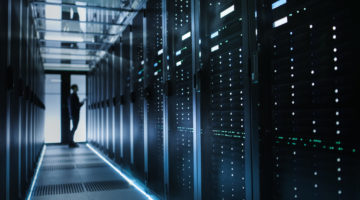
The smart grid
How can we use energy more effectively on a national scale? By creating a ‘smart grid’.
A smart grid relies on data – not only about how much electricity is being produced, but also about demand at a very granular level.
In order to improve stability and restore order to the national grid system, the smart grid is developing out of a number of technological improvements and controls, which should be fully functioning by 2025.
This smart grid simply means the introduction of high tech computers and 2-way communications into the national grid system in the hope that it will help the UK respond to the energy demands of the 21st century, while also work with the planned reduction in carbon emissions.
Historically, the UK has been powered by fossil fuels: for example coal, gas and oil. However more recently, we have seen the introduction of renewable energy into the energy mix. This has put increased pressure on the national grid, since now instead of having a few large power plants, essentially whenever someone gets solar PV installed on their homes, we are having to integrate this extra generating capacity into the grid. We suddenly have millions of mini power plants, and unfortunately the national grid was not meant to work in this way.
The introduction of ‘Smart’
The smart grid, and the smart meter, will allow the consumer to manage electrical energy usage more than ever before, creating a more efficient, more reliable and lower carbon energy industry for all.
Smart grids will focus on:
- Renewable energy distribution
- Demand-side management and time shifting the demand
- Real-time monitoring of grid performance
These three points will allow for:
- Reduced peaks in power usage achieved by handing power stations the prerogative of controlling our smart appliances
- Reduced electrical wastage by delivering instant information on consumption
- The increase the number of ‘smart appliances’ to reduce electrical usage
- Early warnings for blackouts and rapid recovery systems
2-way dialog
One of the main improvements that the smart grid will have over the current national grid system is the introduction of a 2-way digital dialog system. This introduces intelligence, automation and control into the electrical grid. It enables not only the transmission of electricity from grid to home, but also the integration of an intelligent communications network.
So unlike today’s National Grid, which just allows electricity to be delivered into the home, the introduction of this 2-way dialog as part of the smart grid enables real-time energy usage data to be sent from the home back to the energy suppliers. This allows instant meter readings so actual usage can be billed without the need to send someone out to read the meter.
This 2-way dialog increases the potential for consumers to interact more with their energy consumption, helping to reduce peak demand and therefore lowering carbon emissions within the grid.
Real time control
Through the use of the digital communications technology that the smart grid uses, real-time control can be implemented. Both the utility companies and consumers are able to see and monitor electrical usage as it occurs. This real-time control increases the reliability, efficiency and speed of the grid. It also allows for Time of use tariffs, which aims to time-shift the demand, resulting in more evenly distributed electrical usage, so new expensive generating capacity doesn’t need to be built since peak demand will actually fall.
Ability to identify issues within the Grid
Currently, once an area loses power, the Grid is only informed once a customer complains about a lack of electricity. This can therefore lead to a long process of repairs, especially if the problem occurs in the middle of the night and no one contacts the utility company until the morning.
With the introduction of the smart grid, when an area is affected by unforeseen circumstances that causes it to lose power, electricity will automatically be redirected via an alternative route ensuring there is no impact on the customer. This self-healing power of the smart grid, enables rapid fixes and allows for a more reliable, efficient electrical grid.
Better integration of renewables in our energy mix
Since 2006 the amount of electricity produced by renewable energy sources has more than doubled. This includes the massive wind farms that are now dotted around the country as well as individual properties that have solar PV panels on their roofs. This has led to a far more complicated energy mix than we have had to deal with before, with intermittency now having a far larger impact on our energy supply than ever before.
The smart grid allows the energy companies to marry real time production with real time demand, if an issue is spotted or the headroom becomes too tight, a gas power plant can be fired up to help bridge the gap. Hopefully in the future the ability to store energy when demand is low will be available and this can be used to help balance supply and demand.
Using electricity closer to home
One important feature that the smart grid will impose is the introduction of the intelligent allocation of electricity. This means that if you were to flick on the kitchen lights, the electricity required would come from the closest possible source. The current grid has many transmission problems that can lead to the loss of electricity due to the distances the electricity has to travel from the few centralised fossil fuel power plants to the home. However with the smart grid, and the introduction and integration of millions of micro power plants such as wind turbines and solar panels, electricity can be used much closer to home; thus reducing the potential losses transmission creates.
Distribution intelligence
Imagine the whole country coming back from work at 6pm and switching their kettle on, plugging in their electric vehicle to charge and turning on the T.V.
The smart grid would use distributed intelligence, which allows it to recognise these daily trends. This would enable the grid to implement miniscule delays upon the delivery of electricity that relieves pressure and reduces the sudden increase in demand.
Data is administered where electricity is consumed, at the end of the smart grid, and can be analysed in order to make real time decisions on the distribution of electricity. This distribution intelligence will reduce the amount of pressure that the centralised grid is put under, while also multiplying the other benefits of the smart grid.
Operations centres and resilience
The active process of getting electricity from the grid to the place where it’s needed used to be fairly simple. The number of appliances in the UK was at such a number that it allowed for a small quantity of cables to easily transport the electricity. However, as the need for electricity increased, more cables were put up until it became a complex web of criss-crossing wires stretching for miles on end.
This often causes damaging oscillations within the network, which leads to blackouts and a potentially inconsistent supply. However, with the smart grid comes the introduction of new operation centres that use real-time information to help efficiently transform the electricity network into an organised system, effectively reducing the chance of blackouts and failures.
The highly technological smart grid will also have the power to resist attacks and natural disasters through the introduction of extremely assured security protocols.














I am concerned about the expense involved in preparing a smart grid, for my electricty has only been off once in 10 years or so! To monitor my local line means millions of lines across the country must also be moonitored.if the quick return to service is demandwed locally. I am having difficulty reading what I have just typed becasue the text is so faint! please darken it.